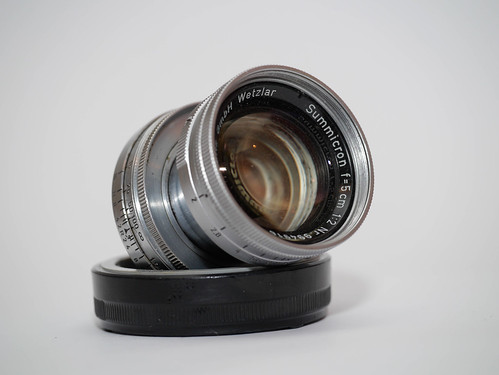Leica Summicron 5cm f2 Collapsible Lens
This month, I am choosing the Summicron 5cm f2 collapsible lens as my Whole Lotta Leica selection. I will pair it up with my Leica M9 for the month and share the results with you here.
The Summicron 50mm has been a benchmark lens for Leica (and for comparisons from other manufacturers) since it was first introduced around 1955. The first version (shown here) was a collapsible lens. Originally made in Leica Thread Mount (LTM), the collapsible was also made in Leica M mount. Mine is an LTM lens.
The collapsible Summicron was an evolutionary step up from the previous Summitar 5cm f2 collapsible, which remains a favorite of vintage Leica shooters.
Mine happens to be an early unit (serial no. 994,XXX), which is classifed as having radioactive glass. There is some disagreement about the meaning of this, but here's a quote from Brian Sweeney, a lens expert with a lot of credibilty:
"Brian Sweeney
04-27-2010, 03:48
The original Summicrons use Thorium Glass and they are radioactive. I own two of them. Summicrons with SN after 105xxxx do not use radioactive glass.
The original prototype Summicrons were marked as Summitars, and had the asterisk (or star) next to the name. I have only seen photographs.
http://www.imx.nl/photo/leica/lenses/lenses/page92.html
The Summar is a double-gauss, 6 elements in four groups, 1-2-2-1 configuration. The Summitar and earlier Summicrons are evolutions of it, 7 elements in 5 groups. The type 2 Rigid Summicron (black, the 70s version) was 6 elements in 5 groups. The modern Summicron went back to the 1-2-2-1 configuration."
If you're interested, you can (click here) to read more about thorium glass, contaminated lanthanum glass, and whether or not the radioactive glass will fog film (it won't at normal distances).
The glass in these lenses is normally yellowed. Some people think it makes these lenses better for black and white shooting. I know it's common to use a yellow filter to increase contrast in blue skies. Or maybe the yellow is worse for color photography?
In any case, mine is in gorgeous condition. It is rare to find one without cleaning marks. I got lucky.
(Click Here) to read a nice summary of the different versions of the Leica Summicron 50mm lenses on antiquecameras.net
The International Leica Society (aka LHSA) is having their Spring Shoot in Ft. Lauderdale, Florida on April 17-20. I'll be taking the Summicron collapsible along for the trip.
By the way, if you aren't a member of LHSA, I highly recommend it. It's a great group. Even though it formerly had "historical" in its name, the LHSA comprises a wide variety of members with experience ranging from the earliest vintage models through the latest digital Leicas. This is not a group stuck in time. In fact, at my first LHSA event, I took a great workshop on high dynamic range (HDR) imaging. That's not an old technology.
In addition to their Spring Shoot and annual meeting, the LHSA holds an annual raffle where they give away extremely expensive and wonderful cameras, and they publish a great journal, known as the Viewfinder. They also offer an electronic membership, where the Viewfinder is delivered as a pdf. Wonderful. No clogging up the mailbox with a paper magazine.
So, check out the LHSA:
(Click Here) and join!
DMC-365.blogspot.com

Nice introduction to this lens with good links. I agree about the value of joining LHSA if you have any interest in Leica photography, collecting and/or just interested in the history.
ReplyDeleteThanks
Bob